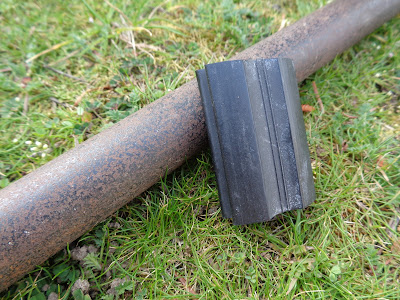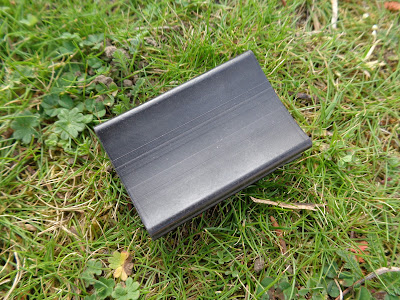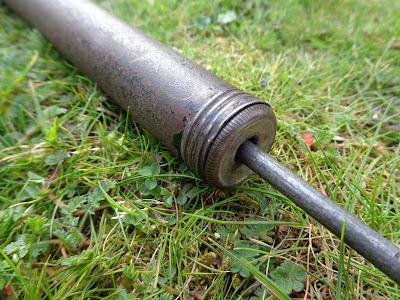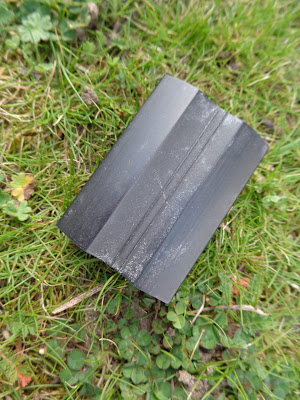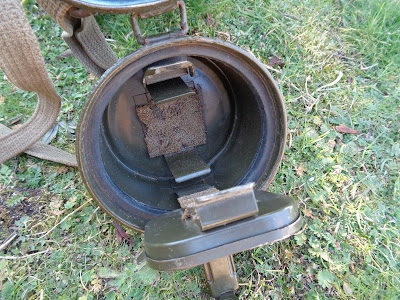This past week has been a big week for new additions to the Polizei Dienstfahrrad, my 1948 German Police Service Bicycle.
I finally tracked down a suitable, vintage, and original, frame mounted tire pump, a new "stomp brake" pad, and even picked up a book that I've had my eye out for! It's been a good week in the Trupenfahrrad world.
Here in the US, it's tough to find authentic Trupenfahrrad parts. You can find them in Europe, but the shipping to the US often makes the deal, "not so great". So I was thrilled to locate a pump here in the good old USA! To make the deal even better, they had a new old stock, "stomp brake" pad! I contacted the seller, struck a deal and ordered them up. Now they're on the bench waiting for restoration and installation.
These old frame pumps were standard for nearly every Truppenfarrad, or Diensfahrrad, or as the German's call the civilian version an "Old Timer" Fahrrad.
These pumps were basically the same as the newer frame pumps that came along, and were widely adopted by most cyclists, in the 1960's, on up to the present day. But instead of modern, lightweight materials, they were old-school steel with a wood handle.
The valve stem fitting was set up for Presta or Woods valves.
This particular pump is complete, but in "restoreable condition". The leather cup inside is oil soaked, torn and rotted. So, until I find, or make, a new leather cup, it won't pump air.
The valve stem fitting needs a new rubber seal.
But, the very best thing about this particular pump, is the fact that it was once on an actual service bike of some sort! The seller said he picked it up in Germany and it was with a batch of similarly marked hand tools, and other old bike pumps. It appears that these came from some sort of government agency at one time.
The pump dates to the 1930's or 1940's, and has a wonderful patina. There are still some traces of the original black paint on the cylinder tube.
The wooden handle is marked with a burned-in brand of RWF, on two sides. I am working on tracking down what this stood for, but for now it adds a great overall look to the pump, and impression on the bike. If any of my readers have information about the "RWF" brand, or have an idea about it, please, let me know in the comments or by email. Thanks!
The ends of the pump have been dimpled, for mounting with a pin clamp on the frame. I have a few leads on some old steel pump mounts, but nothing firm yet.
The brake pad will replace the worn out pad that is currently installed on the bike (probably the original pad!). It should be a fairly straight forward change-out, but when you are dealing with 70+ year old parts, it often gets a bit complicated................
To top off my score on the bike parts, I also found a new copy of the book Radfahrschwadronen. This book covers the WW2 German issued Truppenfahrrad's and is filled with great photos out of the original military manuals, field photos, and other great details. There is just one hitch though, it's in German! Time to brush up on my German skills again!
I also want to add that I recently picked up an original front fender ornament from the same parts seller. The ornament is an original 1930's to 1940's, Victoria Bicycle Company ornament (German). The bike had the original base from an old ornament that was still bolted in place, but the original main part had long since snapped off and disappeared. Now I have a classic, and complete look, for the bike. One step closer to getting the bike back in its original Polizei configuration. (The bike is an original 1948 Dienstfahrrad, for those of you who don't know).
An now that we've reaquainted ourselves with the old "Fahrrad", let's take a closer look at that old pump and pad!
Today's posting will be a quick one. I just received a set of Bundesgrenzschutz equipment straps to add to the growing collection of BGS leather gear.
These straps came to me via a friend in Virginia. He doesn't primarily collect BGS gear and knew I did, and he offered them up. Thanks!
You can view his blog here (he has some vintage East German gear reviewed):
https://gobalgear.blogspot.com/
It is not often I run across these leather BGS straps that are in absolutely, new, and un-issued condition! With that in mind, I figured I ought to document them before they find their way into use in the collection.
These straps are the 22 inch long, equipment straps that are often found on the field packs, or on the equipment belt used to carry a zeltbahn or other rolled cloth items.
These straps are very high quality leather, with a smooth finished, and un-dyed, back surface.
The topside is finely finished, with the embossed lines down both sides.
The roller buckles are stitched in black thread.
The top ends are both stamped with 62 for the year, 1962.
They are stamped with the maker: H. ROGGE, and BERLIN for their city.
The backside ends are ink stamped BGS, indicating their service in the Bundesgrenzschutz. Non-BGS issued straps will not be stamped with the BGS ink stamp (Polizei and other Federal Agencies used these black straps as well).
Let's take a look at a few more photos:
Since we've veered back to the post-war, West German gear again, I figured we'd take a look at another iconic item. A more modern version of the classic, German, Gas Mask Can.
This particular can is considered the "second model", post-war, can that was issued to carry the M54 gas mask. The M54 gas mask was basically a post-war version of the WW2 gas mask, constructed with slightly better materials. The first model post-war can was also a slightly updated, but duplicate, version of the WW2 can.
In 1958, the Bundeswehr "modernized" the gas mask can and came up with the M58, second model can. This can was designed for the "Cold War". This second model was issued from 1958 to 1965, but was actually used clear into the 1980's in some instances. It was officially discontinued when the M65 gas mask was issued, but was carried as long as the older M54 gas masks were still being issued (the M65 will not fit in these earlier type cans).
This second model can, is painted in the classic, Cold War, "Isolation NBC Paint". This paint was designed to protect the gear from contamination from Nuclear, Biological, and Chemical contaminants (NBC). I have no idea what this paint was made with, but it must have been amazing stuff to protect everything from these "contaminants"! The lid also has a rubber gasket to seal everything inside when closed and latched.
These gas mask cans were used by all branches of the German Federal Agencies. Bundesgrenzschutz and Polizei units used this same can and M54 gas masks, but often repainted them in their respective agency colors. This can we're looking at today is painted in the classic Bundeswehr OD Green.
The can is longer than earlier versions, and has horizontal reinforcing grooves on the tube.
The lid is deeper and larger, and contains a double-hinged carrier in the lid.
This carrier held spare lenses, and then the entire lens compartment hinges to reveal a storage area for the anti-fog cloth.
The spring loaded latch is virtually identical to the WW2 versions.
The carry straps are also post-war duplicates of the WW2 carry straps and are often passed off as original WW2 straps to the unsuspecting collector. The weave is coarser, and the color a bit different on these post-war straps. The long looped strap was worn across the body and over the shoulder. The short strap with hook, was used to suspend the can horizontally on the lower back, with the hook on the waist belt.
The cans are lined with a tube of sheet metal and if you look at the bottom, inside, you will see the "gas mask spring". This spring device was used to hold the cleaning cloth in place, in the bottom of the can, when not in use. (Thank you to a very observant follower of the blog......I originally identified this spring as the device that held the mask open when stored. My mistake, and it is now now corrected!)
My can is dated 1960, and bears the PSL makers mark. PSL is the mark for Paul Schulze and Company of Lubeck.
The original owners name strip is still glued into the inside of the lid. Arold Ferdinand.
This can is an essential bit of gear for any 1960's era Bundeswehr display. I plan on mounting this on the back rack of my Polizei Dienstfahrrad (police bicycle). More on that project in a later post!
Here's the photo album of this classic M58 Gas Mask Can.

